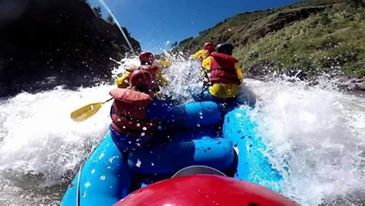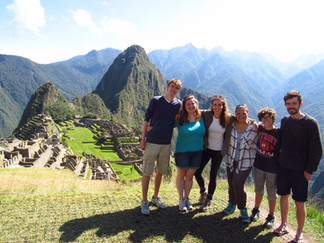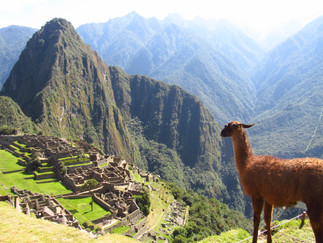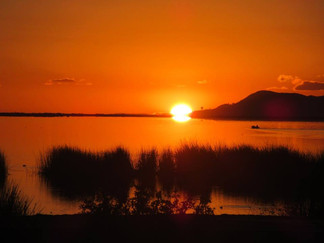¡Viva Perú!
- Amelia

- Jul 13, 2022
- 13 min read
There’s nowhere quite like Peru. If I had to classify just one country in the world as being magical, Peru would be the one. I knew as soon as I decided to do a gap year that I had to go, and so when it came about in 2016 via Latin Link, I was ecstatic. It’s vibrant and colourful, diverse, and utterly breath-taking even in the most unexpected places.
For the tourist, there are endless options of things to do and places to explore. As the majority of our time there was spent on our project (more on this in a future blog post) we weren’t able to do a huge amount of touristy things until our holiday week, but it did mean that we were privileged enough to be fully immersed in Peruvian culture and get to know the country quite well.
Lima
The city of Lima is the third biggest on the South American continent. It’s also known as the City of Kings and the Pearl of the Pacific, and it’s not hard to see why. The colonial architecture is outstanding, and even just walking through the streets, the vibrant diversity is obvious. I was sad not to spend more time there but from the couple of days we had, I absolutely fell in love with it.
By far the best views of the city can be found from the Cross of San Cristóbal, and it may sound like a cliché but at sunset, it's absolutely beautiful. Lima is a vast city, and the views from San Cristóbal go on for miles. It's accessible by bus from near the Plaza de Armas - definitely not one to miss out on. Visiting here was one of my favourite things that we did together during our orientation days - we'd only arrived in Peru about 24 hours beforehand and as introductions go, I'd say this one was rather perfect.
However, if the views you're interested in are more of the oceanic variety, Miraflores is the place to be. Lima boasts a pretty impressive Pacific coastline, and although it hasn't necessarily got the picture-perfect tropical beaches of somewhere like neighbouring Colombia, it's still pretty stunning. Miraflores is the ideal district for tourists - as well as being relatively accessible from most hotels or on public transport, it has so much available to explore: El Parque del Amor with its colourful flowers and beautiful mosaic walls; Larcomar, Lima's cliffside shopping mall; the bustling Mercado Municipal where you can buy countless fruits you've never heard of; and it's also one of the best places to start if you're keen to get going on Lima's gastronomic scene, which is one of the best in the world.
If I were to go back I would...
Explore more of the history. Peru has such a fascinating past, and some of the Incan and pre-Incan artefacts that have been found sound amazing! Lima has plenty of museums to explore, some absolutely beautiful churches and historic buildings, as well as ruins such as Pachacamac close by.
Do a food tour. Peruvian food is flipping amazing (see the tips section further down for some of my favourites), and Lima is absolutely one of the best places in the country to try it.
Cuzco
Possibly the most popular city for tourists in Peru, Cuzco is a must-visit. It’s the perfect base camp for those looking to go to places like the Sacred Valley, Rainbow Mountain, Saqsaywaman, and of course, Machu Picchu. However, in itself, it is still a highly impressive city and not one to be totally overlooked in favour of the sites that surround it - Cuzco boasts some amazing architecture, museums, restaurants, markets, shops, and cultural experiences all by itself. I recommend reserving some time to properly explore the city (and don't rush it - walking up and down hills at 3,400m above sea level is not the easiest) - it really is a gem. It was the Incan capital for 200 years before the conquistadors took over and fortunately, there are still plenty of elements from the pre-Columbian society that have persisted despite everything. We stayed at Atawkama Hostel which is more-or-less central, and as well as being both pretty and comfortable, the staff were great and super accommodating when one of our team had a medical emergency in the middle of the night!
However, that's not to say that you shouldn't leave Cuzco at all! We were recommended Pisac, a small town about an hour's bus ride away which has a beautifully colourful market on each Sunday that's aimed primarily at tourists. Colectivos (minibuses) run from Calle Puputi in Cuzco, leaving whenever they're full, and don't usually cost more than 5 soles for a one-way trip. There's not a huge amount in the town itself, but it's a pleasant day out if you're after some quiet downtime and an opportunity to buy some reasonably-priced souvenirs, plus the bus journey takes you through some of the jaw-dropping scenery of the Sacred Valley which makes it worth the trip all by itself! For the hikers among you, there are also the Incan Pisac ruins at the top of the hill that are said to have some stunning vistas across the valley.
We also got the opportunity to go white-water rafting - very much out of my comfort zone but such a fun experience. I'm sure all of us would wholeheartedly recommend going with Mayuc - we did the full day Urubamba rafting trip which costs about £55 per person and includes everything: the full get-up including safety gear and all the boat equipment; transportation to and from Cuzco; lunch; time in the sauna; a chance to go on the zip wire; and about 2 hours on the water.
If I were to go back I would...
Do more of the Sacred Valley. Peru has some phenomenal scenery on offer, a lot of which lies in the Sacred Valley. It's an especially popular place with those who love the great outdoors - you can hike, camp, go horse-riding, climb, abseil, and lots more!
Machu Picchu
Visiting Machu Picchu was phenomenal. The surrounding Andean peaks and the Urubamba river winding around the base of the mountain all provide a breath-taking view. I was pinching myself the whole day - honestly, what an incredible place. The whole day I was just walking around thinking to myself, "I'm achieving a life goal right now.", and I promise you, it really does live up to the hype.
If you’re not doing the full Inca Trail, then Cuzco is by far the easiest place to start from. There are 2 bus routes which are definitely the best option if you're on a budget, and I'd recommend the Chinchero route from Calle Pavitos over the Pisac route as it doesn't require changing buses. These buses take you to the town of Ollantaytambo, from which you then catch the train, which is by far the best part of the journey. We took the 5:45 am PeruRail train (sounds like madness but I promise it's worth it), which has windows absolutely everywhere so that you can take in as much of the incredible scenery as possible. Honestly, the excitement at the prospect of going to Machu Picchu combined with seeing the sunrise creep over the tops of the Andes is a feeling you never forget! It's also worth looking into any deals they have on for when you're going - we got our tickets 2 for 1 which was such a help to our budgets. The train takes you to Aguas Calientes, a.k.a. Machu Picchu town. From there you can either take the bus up to the site entrance or walk up. We chose the bus – the altitude isn’t too bad (the site is about 2,400 metres above sea level), but it can still be pretty exhausting! It's a bit expensive, about S/70-80, but worth it if you don’t feel up to the trek.
When you reach the entrance there are a lot of tour guides available, most of whom speak English (if they tell you they're the only one that does then that's not true), and are willing to negotiate on price. Getting a guide isn’t compulsory for getting in, but it's definitely worth it if you’re a first-timer as it really helps you to understand the site a lot better as there's not a lot of information that you can glean if you go around by yourself. Our tour took around 2-2.5 hours, then we had the rest of the day to ourselves.
The site is really quite something. The buildings are so well preserved and you’re really able to get a feel for how it would have been to walk around in the time of the Incas. Most of the houses, including a couple of the royal residences, are pretty small and the streets are super narrow in some places, but these are countered by the spacious temples and the wide main plaza. Plus, when you look out at the terraced farmland on the mountainside, or in any direction really, the gorgeous view makes the whole space feel incredibly vast and open.
The entrance ticket also allows you access to the Inca bridge, the Sun Gate, and Machu Picchu mountain, and access to Huayna Picchu (the peak you see in the picture-postcard view) is a little extra. Also, the ticket allows you to go in up to 3 times within the day, so if you want to take a break in Aguas Calientes (which has a really great tourist market - ideal for souvenirs!), grab some food, or use the loo then you can. There is a restaurant just outside the entrance, but we chose to bring our own and ate on the benches just around the corner, which are in quite a pretty covered area with a great view.
Also, make sure you don't miss the llamas - there are quite a few of them that live at Machu Picchu, and they will definitely make your pictures a lot more fun! Do watch out though, there are some fenced-off areas (with very low/subtle fences) that are specifically for them, so don't trip!
Aside from that, the only other bits of advice I would give are these: take plenty of water – there are a lot of steps to get up and the site is bigger than it looks in the photos. Also, do take it slowly if you’re struggling with the altitude. In relative terms, it’s not that high up but it affects everyone differently, so don’t push yourself.
If I were to go back I would...
Hike the whole Inca Trail to get there. It's a major bucket list item - I'm utterly delighted to have been to Machu Picchu and it had always been the ultimate goal, but would I complain about seeing even more Incan sites, mountains, rivers, and some lush jungle? Absolutely not.
Lake Titicaca
There are few places in the world that can make you feel like you're looking at the open ocean when in fact you're in the middle of the mountains. As someone who has grown up by the sea, visiting Lake Titicaca was a sweet relief after 2 months of dust in Huaycán (don't get me wrong, I loved it but flip, the dust levels are unreal) and aside from anything else, it's just stunningly beautiful. At 3,815m above sea level, it's the highest navigable lake in the world and serves as a gateway between Peru and Bolivia, each country having roughly half within their territories. Top tip: because of the altitude it can get pretty chilly - it's rare for temperatures on Lake Titicaca to reach above 19°C, so it's advisable to wrap up or at least take an extra layer. In terms of where to start out from, Puno is an ideal place, as is Juliaca. Puno is closer so we chose to get a hostel there for 2 nights, but both towns provide good access to it.
The tours out onto the lake often take most of the day, so don't make any other plans! The first stop we made was the Uros Islands, which are home to over 1,000 people across more than 120 man-made totora reed islands. Some of the Uru people have some sort of work on the mainland, but for many, their livelihoods come from selling their crafts to or hosting tourists. The majority speak only Aymara, and still lead very traditional lifestyles, relying almost entirely on the lake. It's worth bearing in mind that although you should definitely take your camera, some of the Uru may prefer you not to take photographs of them, as some believe that you're stealing a piece of their soul if you do so.
It's a pretty strange sensation walking on them; you know that you're on an island but the ground has an oddly spongy feel to it, and literally everything is made of reeds. I think most if not all of us felt some sort of delighted bewilderment as to how these constructions can not only stay standing but also be properly lived in or on; it really is so impressive to look at. If you have a little extra cash to splash, as well as the crafts on sale there may also be an opportunity to go onto one of the Uru boats for a short trip, which on average costs about S/10 and is definitely worth it.
The other stop on the day tour is the island of Taquile, the largest natural island on the Peruvian side of the lake. Honestly, if it were a little warmer you could easily mistake it for a Greek island. The walk up from the jetty is a tricky one because of the altitude so pace yourself, but don't let any lightheadedness make you miss out on what's around you. It's absolutely picturesque, especially with the old stone walls, flagstone pathways, and 360-degree views of the lake.
On the main plaza was the restaurant our tour company had booked us into, and it absolutely did not disappoint. I think all of our team went for the fresh-caught Lake Titicaca rainbow trout and oh my days, it was gorgeous. While we were there, there was also a musical parade put on by the locals all in their traditional dress - I'm not sure if there was an official festival or whether it was put on for our benefit, but either way it was an extra blessing in our day. I didn't see that there was a whole lot to do during our 3-4 hours there aside from looking around a small craft market, but honestly, who needs more than that view?
Oh, and one last tip for when you're visiting Lake Titicaca? Get up to watch the sunrise. You won't regret it.
If I were to go back I would...
Stay longer! Although our tour was fantastic, I'd love to spend more time on the Uros Islands and the natural islands such as Taquile. Lake Titicaca is such a peaceful place, so if I had more time there I'd spend as much of it as possible on the water and maybe do an overnight stay on Taquile or Amantani.
Tips for visiting Peru
If you can connect with the locals, absolutely do it. Peruvians, as is the case with most Latin Americans, are so friendly and hospitable and they are often very keen to show off their beautiful country to visitors. If you have the time then it's definitely worth doing a volunteering programme that gets you involved with local people. More on choosing an ethical volunteering trip here.
Don't drink water from the tap unless it's specifically marked as safe. Always buy bottled water or make sure it's filtered.
Don't flaunt your expensive belongings such as cameras and phones, they could easily get stolen if you're too careless.
Don't pet the dogs. Obviously, there is a much higher risk in countries like Peru that dogs will have rabies, but more generally, dogs are trained as guard dogs and are not often kept as just pets. This means that many of them can become quite aggressive if you come too close, so it's not really a good idea unless you're absolutely sure that it's friendly.
Don't miss out on the food. Peruvian food is absolutely amazing! It's bursting with flavour, and because of the amount of contact with the other side of the Pacific, especially China and Japan, there are also some great fusions of Far East Asian flavours as well. My personal favourites in terms of recipes are Lomo Saltado (beef stir-fried in soy sauce and herbs with peppers, tomato, and potatoes), Aji de Gallina (chicken curry), Arroz con Pollo (chicken and rice), and Papa Rellena (seasoned meat wrapped in mashed potato and deep-fried). Also, the colour is a little offputting but I fully recommend Inca Kola! When in a restaurant, be aware that if you ask for 'el menú' then you'll likely be given a set meal, which is often displayed outside or on a board somewhere. If you'd like to choose what you eat then you'll need to ask for 'la carta'.
It is 100% possible to do on a budget. The cost of living in Peru is very low so food, accommodation, and transport are all very affordable for tourists- £1 is roughly S/5, which is the average cost of a lower-key menú there. On the topic of spending, however, you do have to be on the lookout for counterfeit money; more on how to prevent that here.
Important things to remember about hygiene: always wipe your cutlery with a napkin before you eat in a restaurant, and try to avoid meat or pre-cut fruit from street sellers as it's often exposed for most of the day in the heat. Also, washing your hands as much as you can and as thoroughly as you can is super important if you want to avoid getting ill.
When you're at a market or agreeing on a price for a taxi (which you do before you get into it), it's perfectly acceptable to barter. Bartering should always be done respectfully, but it's totally okay to negotiate. When we were in Pisac, for example, one of the team managed to wrangle both an alpaca wool throw and a jumper for S/150, when the original price of the throw alone had been about S/210!
If I were to go back I would...
Explore the history of Trujillo. It's known as 'The City of Eternal Spring'; is home to marinera, the national dance; and it has tons of historical and archaeological sites dating back over 1,500 years. Need I say more?
Fly over the Nazca Lines. Some of the most phenomenal works of art to come out of pre-Columbian Latin America, the Nazca Lines are colossal images carved into the desert sands of southern Peru, and can only be seen in their full glory from above. Definitely one that's high on the bucket list.
Go to the Huacachina Oasis at Ica. Dubbed 'The Oasis of America', Huacachina is one of the biggest tourist attractions in the country, and it's not hard to see why. It's famous for sandboarding on the dunes, lush palm and huapango trees, and for being one of the best centres of wine and pisco production in Peru.
Visit Arequipa. I've heard nothing but good things about Arequipa, it's supposedly very beautiful, and great for those who want to explore more of Peru's history or visit Colca Canyon, the famous home of the condors.
Peru is a phenomenal country and one that's very close to my heart; I hope that when you manage to go that you enjoy it as much as we did, and that this guide has been helpful! Happy travelling, amigos.
Thank you for reading! If you have any questions or if you'd like to guest-write for The Classicist with an Atlas then I'd love to hear from you - you can get in touch via the form on the Contact page or on Instagram @theclassicistwithanatlas.
Photo credits go almost entirely to my wonderful teammates: Abi, Johnny, Joe, Amy, and Seamus. Also, major appreciation has to go to our Latin Link coordinator, Ruth, for the way she looked after us and helped us navigate everything!
None of the links in this post are affiliate links or part of paid advertisements.












































































Comments